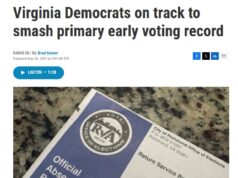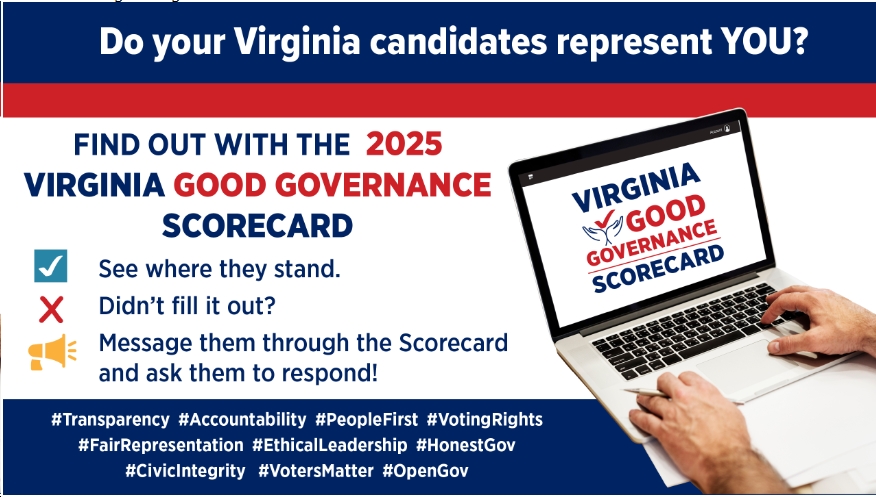( – promoted by lowkell)
Welcome to this twelve part series looking at the challenges, obstacles, and future possibilities of Virginia Democrats. If you’ve missed past diaries, follow these links: Day One, Competitive Districts. Day Two, Turnout Problems. Day Three, Past Mistakes. Day Four, Downstate Democrats. Day Five, Unchallenged Incumbents. Day Six, Present Opportunities. Day Seven, Democratic Trends. Day Eight, Swing Voters. Thank you for reading. No poll this time, but I do have a question at the end I want comments on!
A phantom of darkness suddenly appears, gliding ominously over the ground toward you. Shrouded in the blackest cloak, its head and face are entirely concealed. One skeletal hand stretches out toward your, a boney finger directed behind you. From beneath the hood, you can feel the gaze of two ghostly eyes directing you to turn around. Doing so, you feel transported …
January 2021, Washington DC: A new Republican president prepares to be sworn into office, breaking a twelve-year streak of Democratic control of the White House. A reformer who ran against the extreme conservatives of his own party as much as against Washington as a whole, the new President successfully softened the party’s image among Hispanics, allowing for a crucial win in Florida. He also managed to sell an economic package of small, token spending cuts as a way of financing tax cuts to revive a sluggish economy. But while the 2020 election saw Republicans winning across traditional battlegrounds like the Midwest, they failed to win Virginia. For the fourth Presidential election in a row, the Old Dominion voted blue. But this is no surprise to the casual observer; the state has consistently elected Democratic Senators statewide for over a decade …
About one hundred miles to the south in Richmond, political realities feel vastly different. There are rumors the Republican Governor may join the new administration in Washington, handing over control to his heir apparent in the Lt. Governor’s office. The party adjusted to statewide struggles earlier in the decade to find the winning approach for the lower turnout electorate in 2017. In the absence of a polarizing social conservative leading the ticket, Virginia voters favor the pro-business platform of the Virginia GOP, with its promise of “normalcy” and affordability through low taxes.
Control of the General Assembly is allowing the GOP to map out their pathway to victory for the next decade: gerrymandering. With a popular Governor, the Republicans drove out Democrats from a state senate majority in 2019, upsetting a few long-time incumbents. Virginia may be blue in high-turnout elections statewide, but through careful drawing of district lines the Republicans will ensure that the state continues to be governed by conservatives. And at the Congressional level, party strategists are weighing their options for Virginia’s new 12th Congressional district. With the creation of a new minority-majority district, other competitive seats in Tidewater would be made securely Republican, and there would be no threat of legal entanglement. It would also give Republicans cover in gerrymandering Northern Virginia to take back a crucial swing seat in the suburbs. A two to one advantage, 8 to 4, is nothing to laugh at …
How could this happen?
At the national level, the demographic doom and gloom facing the Republican Party could condemn them to permanent minority party status. But it’s hard to envision a party that is so drunk off their own Kool-Aid that they don’t reform after three back-to-back defeats. Moderating the party’s image among Hispanics and some working class whites could help win Florida and swing states like Ohio, Wisconsin, and Iowa. Virginia’s diversifying population and growing share of college-educated whites, particularly in Northern Virginia, may not match the type of swing state this reformed GOP wins.
But if the Democratic Party is increasingly dependent on strong minority support in high turnout elections, it becomes particularly vulnerable in areas of Virginia in odd-year elections. We should turn the corner later this decade, but there’s a window of danger from 2017 to 2023. Republicans could seize control and jam through a gerrymandering that gives them a shot at partial control of the General Assembly through most of the next decade.
I don’t have to sell you on continued control of the House of Delegates through 2021. In the State Senate, not only is Phil Puckett a vulnerable incumbent, but turnout issues could create a perfect storm to entire defeat Chuck Colgan or win the seat when he retires. I also think there are worrying trends in the Roanoke area that could undermine John Edwards. With a narrowly divided chamber, it doesn’t take too many upsets to see Republicans back in charge.
And the 12th Congressional seat? It’s projected to happen according to the most recent Census estimates of population growth. Would the Republican really give in and draw a minority-opportunity district? The question is would they fear legal repercussions if they didn’t. A Republican Justice Department may not be the most threatening enforcer of the Voting Rights Act, but it’s possible that the case for a second minority-majority district in 2020 will be so overwhelming the courts could have to step in. In a scenario in which Foust or another Democrat occupies the 10th District, Republicans will want an active gerrymandering to take the seat back. A court-drawn redistricting, if a VRA challenge is successful, would deny them that opportunity and could result in a Democratic gain of one or two seats.
What would a Republican gerrymander of 12 seats look like? Start with broadly similar districts in the 9th and 6th in western Virginia. Add two safe Democratic seats in Northern Virginia, and then create two Republican-leaning districts by throwing the rest of the suburbs into districts that run from Fairfax all the way out to just north of Harrisonburg for the 10th and down to Greene county for a new 12th. Add a 1st district running from Fredericksburg to Newport News, and a 7th from various Republican suburbs of Richmond and Central Virginia.
For the two minority-majority districts, run the 3rd along both sides of the James River from Richmond to Norfolk. Another, Southside district (most likely numbered the 4th) runs from Norfolk to Danville. The 2nd remains a potentially competitive district, but as many minority precincts as possible have been removed from it. The 5th is left with the white portions of Southside, some additional Richmond suburbs, and Charlottesville. Both the 10th and the 12th would lean Republican; competitive in a bad year, but well worth the attempt at gerrymandering.
Would Republicans be willing to blow up their 4th District in order to secure two districts elsewhere? Maybe not, but it would certainly be helped if early in the redistricting process Congressman Randy Forbes announces his retirement. Way to take one for the team?
For this diary, I originally was going to have a poll on local or General Assembly Democrat you are most excited to see run statewide or move further up in office. But I realized that my own snapshot of Virginia may be biased, and so I want to hear from you who you are looking forward to supporting in 2017 or beyond. I’m also leaving out some obvious picks who have already run statewide (Chap Petersen, Don McEachin, etc.) Comment below with who you would add to the list!
A few names to start:
Henrico County Commonwealth Attorney Shannon Taylor.
State Senator Adam Ebbin.
Soon to be (keep up the hard work!) State Senator Jennifer Wexton.
Who’s missing?



 Sign up for the Blue Virginia weekly newsletter
Sign up for the Blue Virginia weekly newsletter








